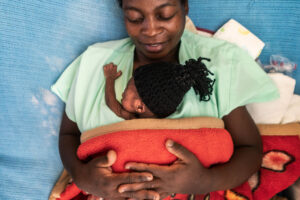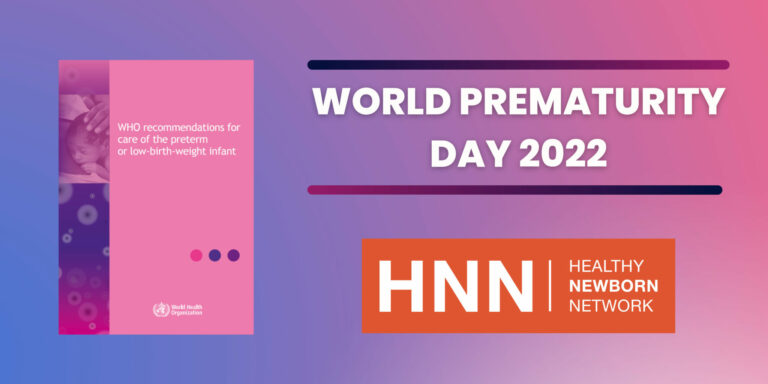The World Health Organization (WHO) launched its new guidelines for care of preterm or low-birth-weight (LBW) newborns on November 17, 2022 – World Prematurity Day.
These recommendations follow a two-year process of systematic reviews and grading of evidence by a group of independent experts. A number of recommendations are new, while others are updates of previous recommendations based on new evidence.
A few highlights or themes resonated as critical issues for countries committed to helping newborns survive and thrive. The most significant is the overriding importance of centering the care of preterm or LBW newborns with their mothers, fathers, and families. For too long, mothers and fathers have been treated as visitors in neonatal units – marginal actors in the care provided to their newborns. In the new guidelines, there is a notable shift in focus to empower families to care for their preterm or LBW newborns. With the WHO’s rigorous processes to ensure that guidelines are evidence-based, we know that these new and updated recommendations reflect interventions that have been shown to improve critical newborn outcomes: survival, growth, and development.
The new guidelines recommend Kangaroo Mother Care (KMC) be used routinely for all preterm and LBW newborns, stipulating that KMC should be provided for as many hours as possible per day, aspiring to achieve at least 8-24 hours. Based on recent evidence of KMC’s benefit when started at home as well as in hospital, the guidelines emphasize the importance of KMC in practically any location as key to newborn survival. One new recommendation based on recent evidence is for KMC to be started as soon as possible after birth, with the mother, father, or a surrogate providing early and continuous KMC. This is a notable change from previous guidelines and clinical practice norms, when babies had limited opportunity to receive KMC while still in neonatal care units, with IV lines, tubes, and while receiving respiratory support. Most KMC occurred in separate KMC units that often required the baby to be stabilized without any need for medical support before KMC could begin. This obviously delayed and limited the opportunity for babies and mothers to experience the well-known benefits of KMC.
With this new guideline implemented, preterm or LBW newborns will see the benefits of KMC from early on, during the critical first days and weeks of life, improving survival and early brain development. Effective implementation is crucial and is best considered on a country-by-country basis. It may require national policy and program change, revised country guidelines for preterm or LBW care, re-training or purposeful mentoring of heath staff, monitoring and use of data for tracking progress in coverage and quality improvement, and new and creative investments in infrastructure, specifically space and furniture, to keep mothers and babies together in neonatal care units, postnatal units, and KMC units.

The guidelines also include a strong recommendation for family involvement facilitated by health care providers. The evidence came from 15 studies investigating a mixed group of interventions involving family members in the care of their preterm or LBW newborn. All the studies evaluated the effects of family-centered models or packages for the hospital care of preterm or LBW infants on infant and parental outcomes. These family-centered packages were several different approaches, but they had in common the involvement of family members in the provision of direct bedside care. Skin-to-skin care or KMC was included in most studies, although the frequency and duration were not described. Other common elements included neurodevelopmental care, preparation for discharge to home, and the involvement of parents in medical decision-making. Most facilities can make the changes required to become more family-centered by adopting new hospital or district-level policies, training for health care providers to involve families in routine care and medical decision-making, and creating family-friendly spaces with necessary amenities: clean water, food and eating utensils, toilet and shower facilities, and comfortable, safe, and nearby sleeping spaces.
The guidelines also address care at home after discharge. Any trained provider – doctors, nurses, midwives, community health workers – can provide follow up care to these vulnerable newborns and families as they continue to practice KMC at home. They can also provide lactation support, immunization counselling, assess for danger signs, and ensure parents know where to go for emergency care. Evidence on this intervention supported improved newborn outcomes, including mortality, as well as increased immunization rates and exclusive breastfeeding at 6 months. Implementation will require local prioritization of resources and delivery platforms to provide extra home visits to preterm or LBW newborns, beyond the routinely recommended four postnatal visits. Community-level health workers need to be trained and empowered to provide care for babies in KMC, babies learning to breastfeed, and to recognize and teach danger signs. In many countries, training materials for health workers to provide effective home visits to discharged preterm or LBW newborns may need to be developed.
In conclusion, these new guidelines promote adoption or adaptations of effective family-oriented interventions that enhance newborn survival, newborn growth and development, and family well-being. We must join together – governments and policymakers, programmers, professional societies, partners, donors, and families – to galvanize the political will to implement, sustain, and scale up this package of effective interventions to benefit preterm or LBW infants.
